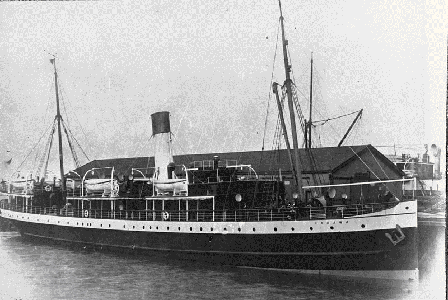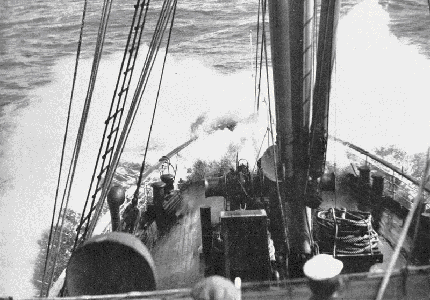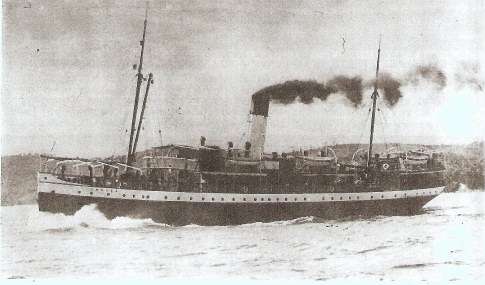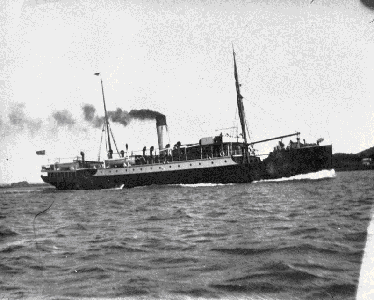The Ultimate New Zealand Soccer Website | home
Pacific Viking | Paloma | Parera | Paroto | Pateke | Poranui | Port De France | Port Waikato | Pukeko | Puriri | Ransdorp | Rarawa | Rata | Ratanui | Rex Star | Rigon | Rimu | River City | Ronaki | Rosalie | Rosalind Star | Ryujin Maru No. 8 | Sami | Sami II | San Te Maru No. 17 | Sea-Tow | Sigrid S | Slotergracht | Spirit Of Enterprise | Spirit Of Freedom | Spirit Of Progress | Spirit Of Resolution | Spirit Of Vision | Squall | Storm | Sundry Tugs | Svendborg Gate
Rarawa
 JT Diamond collection, Auckland Libraries, JTD-19M-02355 - a 1920s shot alongside
The 1071 ton "Rarawa" succeeded "Ngapuhi" on Northern Steam Ship Company's Onehunga - New Plymouth run, which it maintained under Captains Norbury and Bark between mid-October 1903, upon arrival from Dundee, Scotland, and 1929.
This was a joint service with Union Company for twenty-one years from mid-1909. Prior to that, Northern and Union worked a two-way service six days out of seven, with "Rarawa" boasting accommodation for 190 passengers - she once carried 500 passengers!!! - heading north three nights a week from New Plymouth, with "Rotoiti" (one night) and "Takapuna" (two nights) heading to Onehunga on alternative nights.
It was a popular outing to travel to Onehunga on the 2.10pm 'boat train' on a Sunday, see "Rarawa" depart, then return to the city on a double-decker electric tram.
 JT Diamond collection, Auckland Libraries, JTD-19M-02890 - crossing the Bar in the 1920s
One trip south took longer than expected, as "Rarawa" stuck fast on a mudbank just after clearing Onehunga Wharf. It took over an hour before she could resume her passage.
On another occasion, 27 May 1909 to be precise, she set sail from Onehunga, and got as far as Point Puponga when a boiler tube burst, due to the water level having been allowed to fall too low to power it. She returned to port the following day with just one boiler operating, and her passengers were transferred to "Takapuna" while repairs were administered.
She lost two passengers overboard on Onehunga - New Plymouth runs over the years, in October 1910 and July 1916, and had two collisions at Onehunga, bumping the steamer "Karamu" while berthing, and a New Year's Day 1926 coming together with "Zita".
 Sourced from Auckland Museum & Institute
Her longest-serving Captain, Scottish-born "Billy" Bark, took over the helm from Captain Norbury in 1914, having been Chief Officer in the years prior. He was in charge for the rest of "Rarawa"'s career, then switched to "Ngapuhi" before the curtain came down on the steam-powered service which had connected Onehunga and New Plymouth sincr the turn of the century.
During his career, he's estimated to have made around 7000 crossings of the Manukau Bar, the most testing of which occurred circa 6pm on 30 April 1924, when "Rarawa" was southward-bound. A large wave swept across the ship, taking with it the bridge rail and barricade, plus the telegraphic signals facility, restricting communication to the engine room to word of mouth from the bridge via a man stationed at the engine room skylight!
Another tough trip occurred on 19 March 1918, when "Rarawa" arrived off New Plymouth with 51 passengers on board. They were confined below decks while Captain Bark took the ship in in the middle of a hurricane-like gale which severely restricted visibility - the signals from shore couldn't be seen! Despite pitching and rolling wildly in the decidedly inclement conditions, the ship came through unscathed and berthed safely.
 JT Diamond collection, Auckland Libraries, JTD-19M-01198 - under way on another voyage
to New Plymouth in 1910
There is one claim to fame on which "Rarawa" will never be beaten - the most frequent visitor to the Port of Onehunga. Sadly, we'll never know the exact number, as the Marine Department records of Onehunga movements were consumed by fire some years ago.
However, it's estimated that she made over 2200 visits to the port from 1903 - she certainly made 1441 calls from the time records were first maintained, in July 1913, to her final call in June 1929, "Rarawa" departing for Kawhia at 1645 on 4 June.
She eventually ended up in Auckland's Shoal Bay, sitting there for eight years until June 1937 when her scrapping was announced. The ship's bell was gifted to New Plymouth by the Northern Steam Ship Company, and was transported aboard "Hauturu" in October 1937 before being presented to the Taranaki Museum, where it remains on display to this day, along with a scale model of the most significant ship in the first one hundred years of operations at the Port of Onehunga.
|